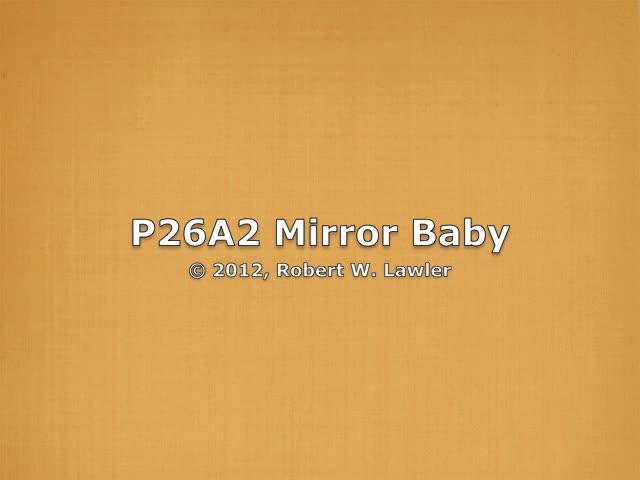
P26A2 Clip Notes
The course of our “experiments”, as this one shows explicitly, were determined less by our plans than by Peggy’s interest in the opportunities afforded her by the concrete context in which we engaged her.
| Notes:n:nn | by Analyst, 10/21/2024 |
| Setting,Props | Cedar Hall, Family Room: |
| Actors,Aims | Peggy and Mom; Bob on camera. |
| Episode A: | Peggy: [bumps her head on the mirror] Bob: Why don’t you give her the spoon first? And after she plays with the spoon for a while, give her the other things. Mom: She’s working on playing with that baby in the mirror. Bob: Well, she didn’t react very strongly when she played with Adam yesterday, did she? She didn’t play with him at all. Mom: No. She looked at him curiously once or twice. |
| Episode B: | Mom: That’s me. That’s my knee. Peggy: [bumps her head on the mirror] Mom: Can you see her step back and blink? Bob: Banging heads with that other baby, huh, Peggy? Mom: And then she, she pulled back a little blinked and surprised. Bob: This reminds me of that that scene from the Marx Brothers movie (“Duck Soup”, famous mirror scene)… |
| Episode C: | Mom: [to Peggy] What do you think about that thing? Mom: Is that a good thing? Peggy: [delighted interactions, no words] Mom: The boy is hitting your head. Bob: Does it look as though she’s trying to communicate with the other baby, anyway, at all? Peggy: I don’t know. Mom: It looks as though she’s trying to get through, trying to catch, but she seems to be… Peggy: [bumps her head on the mirror] {Mom: Oh, wow} Mom: She seems to be amused by the fact that the other baby is doing exactly the same thing. Bob: Including the head banging. |
| Episode D: | Can you distract her from that game? Because it looks as though she’s going to cry if she bangs her head anymore. Turn her around this way. |
| Episode | |
| Summary by AI |
Caregivers suggest giving Peggy a spoon first, then other objects, to engage her. Peggy becomes focused on the “baby” in the mirror, repeatedly interacting with her reflection. Compared to the previous day with Adam, she showed little interest in another real child. She identifies parts of herself (“That’s me… That’s my knee”) while near the mirror. Peggy bumps her head on the mirror, steps back, and blinks in surprise, then resumes. Observers note the mirrored “head-banging” and Peggy’s amusement at the synchronized actions. A question arises whether she’s trying to communicate with the “other baby” in the mirror. Observers think she may be trying to reach or catch the other, yet is entertained by mimicry. There’s a humorous reference to the Marx Brothers’ Duck Soup mirror scene. Concern grows about safety; caregivers consider distracting and turning her away to prevent crying. |
| Narrative by AI |
A small moment in a living room unfolds into a fascinating glimpse of early development: a baby, Peggy, encounters a mirror. At first, it’s simple exploration—touches, glances, and the clink of a spoon suggested by nearby adults. Then curiosity concentrates. Peggy bumps her head lightly against the glass, steps back, and blinks. There’s surprise, then delight. The “other baby” matches her every move, including the head bumps, and a pattern emerges that is as amusing as it is instructive. Observers nearby wonder aloud: is Peggy trying to communicate with the baby in the mirror? From the scene, it appears she alternates between reaching toward the image and being captivated by the precise synchrony of movements. She looks, tests, and responds. The rhythmic correspondence—her action mirrored instantly—seems to both puzzle and entertain her. For a moment, it evokes the famous “mirror scene” from the Marx Brothers’ Duck Soup, where perfect imitation blurs identity and intention. What’s happening here aligns with a common developmental trajectory. Infants typically begin by treating reflections as social stimuli—another baby to watch—before gradually noticing the perfect contingency between their actions and the image. Recognizing “that’s me” tends to emerge later, often signaled by behaviors like touching a mark on one’s own face after seeing it in the mirror. In this scene, the remarks “That’s me” and “That’s my knee” sit alongside ongoing curiosity, suggesting a transitional phase between social interest and self-recognition. Peggy appears engaged in discovery: not quite communicating with a separate other, but not fully abstracting the reflection as self either. The head-bumping, while light and exploratory, highlights another dimension: infants often learn through gentle trial and error, testing surfaces and cause-and-effect. Here, adults step in to guide the play, offering alternatives (like a spoon) and keeping an eye on safety. The suggestion to redirect her attention after repeated bumps reflects a balance between allowing exploration and preventing distress. The laughter and delighted sounds indicate that, within safe bounds, this kind of mirror play can be both enriching and enjoyable. In the span of a few minutes, Peggy’s mirror interaction shows how early experiences weave together perception, motor exploration, social curiosity, and budding self-awareness. What looks like simple play is layered: testing boundaries, noticing patterns, and gradually mapping the line between self and other. Whether through a classic film reference or a baby’s blink of surprise, mirrors invite us to see development in action—quietly, playfully, and in real time. |
| Link Index | Panel P026, Language Development, Object Exploration, Social Interactions |
| Themes, Interplay |
